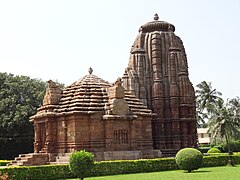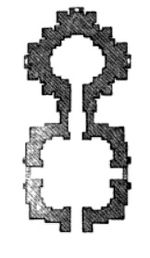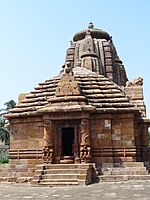Rajarani Musical Festival 2014 | ||||||||||
| ||||||||||
Rajarani Temple
Rajarani Temple 
Geography Coordinates 20°14′36.4″N 85°50′36.68″ECoordinates: 20°14′36.4″N 85°50′36.68″E Country India State Odisha Location Bhubaneswar Culture Primary deity Shiva Architecture Architectural styles Kalingan Pancharatha Style
(Kalinga Architecture) History and governance Date built 11th century
Rajarani Temple is an 11th-century Hindu temple located in Bhubaneswar, the capital city of Odisha (Orissa previously), India. The temple is originally believed to be known as Indreswara and locally known as "love temple" on account of the erotic carvings of women and couples in the temple. Rajatemple is built on pnahcratha style on a raised platform with two structures; a central shrine namely the vimana (sanctum) with the bada(the curvilinear spire) over its roof raising up to a height of 18 m (59 ft) and a viewing hall called jagamohana with a pyramidal roof . The temple was constructed of dull red and turbid yellow sandstone locally called "Rajarani". There are no images inside the sanctum and hence it is not associated to specific sect of Hinduism, but broadly classified as Saivite based on the niches.
Various historians place the original construction date between the 11th and 12th centuries and have placed it roughly belonging to the same period of the Jagannath Temple at Puri. The architecture of other temples in central India is believed to have originated from the temple, with the notable ones being the Khajuraho temples and Totesvara Mahadeo temple in Kadawa. The are various sculptures in the walls around the temple and the vimana depicting scenes of marriage of Shiva, Nataraja, Parvati, tall slender sophisticated nayikas depicted in various roles and moods such as turning her head from an emaciated ascetic, fondling her child, holding a branch of tree, attending to her toilet, looking into mirror, taking off her anklet, caressing her pet bird and playing instrument. Rajarani temple is maintained by the Archeological Survey of India (ASI) as a ticketed monument.
| Rajarani Temple | |
|---|---|
 | |
| Geography | |
| Coordinates | 20°14′36.4″N 85°50′36.68″ECoordinates: 20°14′36.4″N 85°50′36.68″E |
| Country | India |
| State | Odisha |
| Location | Bhubaneswar |
| Culture | |
| Primary deity | Shiva |
| Architecture | |
| Architectural styles | Kalingan Pancharatha Style (Kalinga Architecture) |
| History and governance | |
| Date built | 11th century |
Rajarani Temple is an 11th-century Hindu temple located in Bhubaneswar, the capital city of Odisha (Orissa previously), India. The temple is originally believed to be known as Indreswara and locally known as "love temple" on account of the erotic carvings of women and couples in the temple. Rajatemple is built on pnahcratha style on a raised platform with two structures; a central shrine namely the vimana (sanctum) with the bada(the curvilinear spire) over its roof raising up to a height of 18 m (59 ft) and a viewing hall called jagamohana with a pyramidal roof . The temple was constructed of dull red and turbid yellow sandstone locally called "Rajarani". There are no images inside the sanctum and hence it is not associated to specific sect of Hinduism, but broadly classified as Saivite based on the niches.
Various historians place the original construction date between the 11th and 12th centuries and have placed it roughly belonging to the same period of the Jagannath Temple at Puri. The architecture of other temples in central India is believed to have originated from the temple, with the notable ones being the Khajuraho temples and Totesvara Mahadeo temple in Kadawa. The are various sculptures in the walls around the temple and the vimana depicting scenes of marriage of Shiva, Nataraja, Parvati, tall slender sophisticated nayikas depicted in various roles and moods such as turning her head from an emaciated ascetic, fondling her child, holding a branch of tree, attending to her toilet, looking into mirror, taking off her anklet, caressing her pet bird and playing instrument. Rajarani temple is maintained by the Archeological Survey of India (ASI) as a ticketed monument.
Contents
History[edit]
- nBhubaneswar
- nBhubaneswar
Architecture[edit]
The Orissan temples have two parts namely the sanctum (deul or vimana) and the other is place from where pilgrims view the sanctum (called jagamohana). The initial deul temples were without the jagamohana as seen in some of the older temples in Bhubaneswar, while the later temples had two additional structures namely nata-mandapa (festival hall) and bhoga-mandapa (hall of offerings). The vimana is square in plan and the walls are variegated by ressaults (called rathas or pagas).[9] Amalaka (also called mastaka), a stone disk with ridges on the rim is placed over the bada (tower) of the temple. Rajarani Temple stands on a raised platform. The temple was constructed of dull red and turbid yellow sandstone locally called "Rajarani".[7]
The Orissan temples have two parts namely the sanctum (deul or vimana) and the other is place from where pilgrims view the sanctum (called jagamohana). The initial deul temples were without the jagamohana as seen in some of the older temples in Bhubaneswar, while the later temples had two additional structures namely nata-mandapa (festival hall) and bhoga-mandapa (hall of offerings). The vimana is square in plan and the walls are variegated by ressaults (called rathas or pagas).[9] Amalaka (also called mastaka), a stone disk with ridges on the rim is placed over the bada (tower) of the temple. Rajarani Temple stands on a raised platform. The temple was constructed of dull red and turbid yellow sandstone locally called "Rajarani".[7]
Vimana[edit]
vimana (tower) is clustered by miniature towers with double crowning elements and appears round, unlike other temples in Bhubaneswar, but like the towers of Khajuraho temples. The temple stands on a plinth with three mouldings. The bada consists of five divisions instead of three divisions, usually found in other temples. The vimana rises to a height of 17.98 metres (59.0 ft) from the basement.[7] The vimana (sanctum) measures 10.25 ft (3.12 m)*10.25 ft (3.12 m) from the inside, 31 ft (9.4 m)*29 ft (8.8 m) from the outside.[10] Its spire is decorated with clusters of turrets (replication of the spire itself) emerging form the rib of the spire. The temple has panchanga bada or five divisions namely, pabhaga, talajangha, bandhana, uparajangha and baranda. The lowermost division is called pabhaga having five decorative mouldings namely, khura, kumbha, patta, kani and basanta. The superstructure (gandi) of the temple has a number of miniature turrets (angasikharas). The superstructure is crowned with a fluted disc shaped architectural members called amalakaand a vase (kalasa) surmounts it as the crowning finial.[1][11][12]
Jagamohana[edit]
vimana (tower) is clustered by miniature towers with double crowning elements and appears round, unlike other temples in Bhubaneswar, but like the towers of Khajuraho temples. The temple stands on a plinth with three mouldings. The bada consists of five divisions instead of three divisions, usually found in other temples. The vimana rises to a height of 17.98 metres (59.0 ft) from the basement.[7] The vimana (sanctum) measures 10.25 ft (3.12 m)*10.25 ft (3.12 m) from the inside, 31 ft (9.4 m)*29 ft (8.8 m) from the outside.[10] Its spire is decorated with clusters of turrets (replication of the spire itself) emerging form the rib of the spire. The temple has panchanga bada or five divisions namely, pabhaga, talajangha, bandhana, uparajangha and baranda. The lowermost division is called pabhaga having five decorative mouldings namely, khura, kumbha, patta, kani and basanta. The superstructure (gandi) of the temple has a number of miniature turrets (angasikharas). The superstructure is crowned with a fluted disc shaped architectural members called amalakaand a vase (kalasa) surmounts it as the crowning finial.[1][11][12]
Jagamohana[edit]
Sculptures[edit]
The sculptures have a depth that was lacking in the
Mukteswara Temple sculptures.[11] The slightly projected entrance is flanked by round thick columns entwined by naga on the left. Guardians of the eight directions project from the base of the temple in the eight directions, starting from the gateway in a clockwise direction around the porch and the deul to end back at the torana (entrance).[11] The other noted sculptures are naga-nagi sthambha, saiva dwarapalas on the entrance doorjambs and Lakulisa on the lintel of entrance above which is the architrave of Navagrahas are present. The best preserved sculpture of the temple are the standing astadikpalas on the central façade of kanikaappearing on the jangha portion of the bada clad in diaphanous drapery. The image of Varuna is intact and notable for its body ornamentation, coiffure and facial expression. Scenes of marriage of Siva, Nataraja, Parvati are the cult images present in the temple. There are tall slender sophisticated nayikas gracing the walls of the sanctum depicted in various roles and moods in amorous dalliance with actions such as turning her head from an emaciated ascetic, fondling her child, holding a branch of tree, attending to her toilet, looking into mirror, taking off her anklet, caressing her pet bird and playing instrument. There are also erotic (mithuna) figures carved in high relief on the projecting portions of the uparajangha. The other decorative motifs are carved in the shape of vyala, jagrata and gajakranta. The scroll motifs are the foliages, creepers and vines (vanalata), each containing lush foliage independent of any stalk or vine.[1]
The sculptures have a depth that was lacking in the
Mukteswara Temple sculptures.[11] The slightly projected entrance is flanked by round thick columns entwined by naga on the left. Guardians of the eight directions project from the base of the temple in the eight directions, starting from the gateway in a clockwise direction around the porch and the deul to end back at the torana (entrance).[11] The other noted sculptures are naga-nagi sthambha, saiva dwarapalas on the entrance doorjambs and Lakulisa on the lintel of entrance above which is the architrave of Navagrahas are present. The best preserved sculpture of the temple are the standing astadikpalas on the central façade of kanikaappearing on the jangha portion of the bada clad in diaphanous drapery. The image of Varuna is intact and notable for its body ornamentation, coiffure and facial expression. Scenes of marriage of Siva, Nataraja, Parvati are the cult images present in the temple. There are tall slender sophisticated nayikas gracing the walls of the sanctum depicted in various roles and moods in amorous dalliance with actions such as turning her head from an emaciated ascetic, fondling her child, holding a branch of tree, attending to her toilet, looking into mirror, taking off her anklet, caressing her pet bird and playing instrument. There are also erotic (mithuna) figures carved in high relief on the projecting portions of the uparajangha. The other decorative motifs are carved in the shape of vyala, jagrata and gajakranta. The scroll motifs are the foliages, creepers and vines (vanalata), each containing lush foliage independent of any stalk or vine.[1]
Religious significance[edit]
Festivals[edit]
Search Results
Rajarani Temple
-
www.orissatourism.gov.in/new/rajarani.html
The Rajarani temple, dating back to the eleventh century, is set in open paddy fields, and the ... The name of the temple has been the subject of much debate.
· Write a review
Tankapani Rd, Rajarani Colony, Rajarani Temple, Bhubaneshwar, Odisha 751001
1800 208 1414
- www.orissatourism.gov.in/new/rajarani.htmlThe Rajarani temple, dating back to the eleventh century, is set in open paddy fields, and the ... The name of the temple has been the subject of much debate.5 Google reviews
Tankapani Rd, Rajarani Colony, Rajarani Temple, Bhubaneshwar, Odisha 751001 1800 208 1414
Rajarani Temple - Wikipedia, the free encyclopedia
-
https://en.wikipedia.org/wiki/Rajarani_Temple
Rajarani Temple is an 11th-century Hindu temple located in Bhubaneswar, the capital city of Odisha (Orissa previously), India. The temple is originally believed
-
More images for rajarani temple
- https://en.wikipedia.org/wiki/Rajarani_TempleRajarani Temple is an 11th-century Hindu temple located in Bhubaneswar, the capital city of Odisha (Orissa previously), India. The temple is originally believed
... -
More images for rajarani temple
Rajarani Temple, Bhubaneswar - Ticketed Monument ...
-
asi.nic.in › Monuments › Ticketed Monuments › Orissa
The Rajarani temple, Bhubaneswar (Lat.200 15' N Long. 850 50' E) in the district of Khurda is located towards north-east of Lingaraj temple is one of the most ...
- asi.nic.in › Monuments › Ticketed Monuments › OrissaThe Rajarani temple, Bhubaneswar (Lat.200 15' N Long. 850 50' E) in the district of Khurda is located towards north-east of Lingaraj temple is one of the most ...
Rajarani Temple - Orissa Tourism
-
www.orissatourism.org/travel-to.../rajarani-temple-bhubaneshwar.html
The Rajarani temple (bhubaneshwar) - The temple name has been derived from local sandstone used to built it. Explore more on Raja Rani Temple.
- www.orissatourism.org/travel-to.../rajarani-temple-bhubaneshwar.htmlThe Rajarani temple (bhubaneshwar) - The temple name has been derived from local sandstone used to built it. Explore more on Raja Rani Temple.
Rajarani-Temple-Bhubaneswar (2012) - YouTube
-
www.youtube.com/watch?v=ia1MEwyaIs0
Jan 9, 2013 - Uploaded by Umakant Mishra
Rajarani temple is one of the famous temples in the temple city of Bhubaneswar. This temple showcases the ...
- www.youtube.com/watch?v=ia1MEwyaIs0Jan 9, 2013 - Uploaded by Umakant MishraRajarani temple is one of the famous temples in the temple city of Bhubaneswar. This temple showcases the ...
[PDF]THE RAJARANI TEMPLE AT A GLANCE - Odisha
-
www.odisha.gov.in/portal/LIWPL/.../143Rajarani_Music_Festival.pdf
titled Ekamra- Utsav; the Temple City festival has been conceived. This day's long ...Rajarani Temple is famous for its sculpted figures and the successive tiers
- www.odisha.gov.in/portal/LIWPL/.../143Rajarani_Music_Festival.pdftitled Ekamra- Utsav; the Temple City festival has been conceived. This day's long ...Rajarani Temple is famous for its sculpted figures and the successive tiers
...
Rajarani Temple - TripAdvisor
-
www.tripadvisor.in › ... › Bhubaneswar › Places to visit in Bhubaneswar
- www.tripadvisor.in › ... › Bhubaneswar › Places to visit in BhubaneswarRajarani Temple, Bhubaneswar: See 85 reviews, articles, and 65 photos of Rajarani Temple, ranked No.9 on TripAdvisor among 57 attractions in Bhubaneswar.
Rating: 4 - 85 reviews
5 Must See Temples in Bhubaneswar Orissa - India Travel
-
goindia.about.com › ... › Regions in India › Orissa
Bhubaneshwar, Odisha's capital and one of the state's top tourist places, is renowned for being a city of temples -- after all, there are more than 700 of them!
- goindia.about.com › ... › Regions in India › OrissaBhubaneshwar, Odisha's capital and one of the state's top tourist places, is renowned for being a city of temples -- after all, there are more than 700 of them!
Rajarani Temple - Indian Mirror
-
www.indianmirror.com/temples/rajarani-temple.html
The Rajarani temple is one of the most renowned and famous temples in Bhubaneswar which is the capital city of Orissa. It was built between the 10th and 11th ...
- www.indianmirror.com/temples/rajarani-temple.htmlThe Rajarani temple is one of the most renowned and famous temples in Bhubaneswar which is the capital city of Orissa. It was built between the 10th and 11th ...
Searches related to rajarani templerajarani temple pictures
See also[edit]
Rajarani Temple - Bhubaneswar, Odisha - YouTube
www.youtube.com/watch?v=5I1-Yzm_fOsJul 2, 2014 - Uploaded by WildFilmsIndiaRajarani temple is set amidst swaying paddy fields and which is surrounded by blooming flowers in Old ...Rajarani temple (11th century) , Bhubaneswar, Odisha ...
www.youtube.com/watch?v=2NDc_tYTIvcNov 7, 2013 - Uploaded by jai prakash SinghIRajarani temple is managed by ASI (archaeological survey of india) and it is not an active temple .Name of ...Raja Rani Temple-Bhubaneswar - YouTube
www.youtube.com/watch?v=qFDnpW2SSJcAug 14, 2014 - Uploaded by Michel RangilaIt is based on ancient monuments.it is situated at bhubaneswar,odisha. it is very old era`s temple.it has very ...Rajarani temple, Bhubaneswar, Orissa - YouTube
www.youtube.com/watch?v=IdnuqdhSs-MOct 21, 2013 - Uploaded by Jayaraman d.r.It is a Siva temple today void of the linga. Rajarani is actually name of the stone used in the temple ...Rajarani Temple : One of the architectural wonders of ...
www.youtube.com/watch?v=Y6lraBuEJOYJul 2, 2014 - Uploaded by WildFilmsIndiaRajarani temple is considered as one of the architectural wonders of Odisha. The temple is set amidst swaying ...Rajarani Temple In Bhubaneswar - Odisha | India Video ...
www.youtube.com/watch?v=5YkvCcH3YE0Apr 27, 2014 - Uploaded by indiavideodotorgRajarani Temple In Bhubaneswar - Odisha | India Video Originally believed to be known as Indreswara, it is ...Raja Rani Temple-Bhubneswar, Orissa - YouTube
www.youtube.com/watch?v=1I-uRHmffLwApr 2, 2014 - Uploaded by san anThis documentary is based on history, it is very popular temple, it is very beautiful. it attracts the tourist.it is very ...Rajarani Temple in Bhubaneswar, Odisha - YouTube
www.youtube.com/watch?v=IuZNFw0mV6YJul 2, 2014 - Uploaded by WildFilmsIndiaDevotees at Rajarani Temple in Bhubaneswar, Odisha. The temple is set amidst the swaying paddy fields and ...Rajarani Temple of Bhubaneswar-Odisha - YouTube
www.youtube.com/watch?v=kX2xjgwxQ1kJun 8, 2014 - Uploaded by san anThis documentary is based on odisha`s opld culture.it is very oldtemple.it is made of racha Ragini Stones,it is ...
Stay up to date on results for rajarani temple.
Create alert



No comments:
Post a Comment